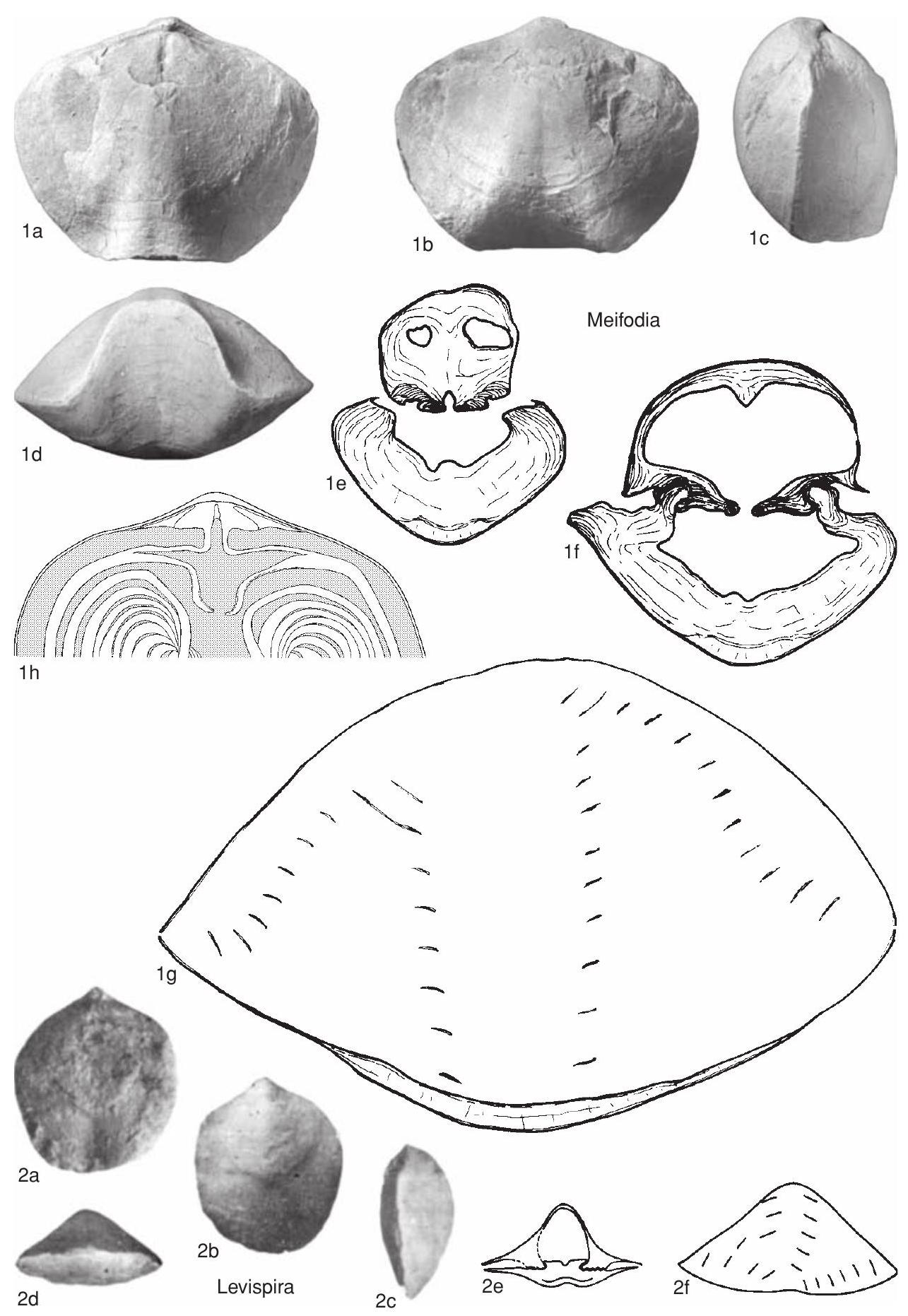Welcome to the Treatise on Invertebrate Paleontology!
Please enter a genera name to retrieve more information.

Meifodia
Classification
Phylum:
Brachiopoda
Class:
Rhynchonellata
Order:
Atrypida
Superfamily:
Lissatrypoidea
Family:
Lissatrypidae
Formal Genus Name and Reference:
Meifodia WILLIAMS, 1951, p. 106
Type Species:
Hemithyris subundata M'COR, 1851, p. 394, OD
Images
(Click to enlarge in a new window)
Fig. 993, 1a-h. *M. subundata (M'Cor), Rhuddanian, United Kingdom, $a-d$, dorsal, ventral, lateral, anterior views, x2$, $e-g$, serial sections, x5$, $h$, reconstruction of brachidia, x5$ (Copper, 1995).
Synonyms
Tyrothyris
Geographic Distribution
Eurasia, North America
Age Range
Beginning Stage in Treatise Usage:
Silurian (Llandovery)
Beginning International Stage:
Rhuddanian
Fraction Up In Beginning Stage:
0
Beginning Date:
443.07
Ending Stage in Treatise Usage:
Silurian (Llandovery)
Ending International Stage:
Telychian
Fraction Up In Ending Stage:
100
Ending Date:
432.93
Description
Medium, equally wide as long or wider than long, dorsibiconvex, straight hinge, small anacline-hypercline area usually obscuring apical-transapical foramen, deltidial plates commonly lost in adult shells, prominent, broad, angular, anterior fold on commissure, solid teeth, ventral valve with long, slightly arcuate, subparallel vascular canals, hinge plate divided by cardinal pit, straight, horizontal inner socket ridges, dorsomedially directed spiralia with fewer than 10 whorls, long, simple, posteroventrally located jugal processes, with hooklike jugal plates. [Distinct from Cerasina in the possession of ventral jugal processes (instead of dorsal jugum), wide shell with broad fold; differs from Australina by its convexity, strong anterior fold; may be confused with septatrypinids, but for solid teeth lacking dental cavities.]
References
Museum or Author Information
Classification
Phylum:
Brachiopoda
Class:
Rhynchonellata
Order:
Atrypida
Superfamily:
Lissatrypoidea
Family:
Lissatrypidae
Formal Genus Name and Reference:
Meifodia WILLIAMS, 1951, p. 106
Type Species:
Hemithyris subundata M'COR, 1851, p. 394, OD
Images
(Click to enlarge in a new window)
Fig. 993, 1a-h. *M. subundata (M'Cor), Rhuddanian, United Kingdom, $a-d$, dorsal, ventral, lateral, anterior views, x2$, $e-g$, serial sections, x5$, $h$, reconstruction of brachidia, x5$ (Copper, 1995).
Synonyms
Tyrothyris
Geographic Distribution
Eurasia, North America
Age Range
Beginning Stage in Treatise Usage:
Silurian (Llandovery)
Beginning International Stage:
Rhuddanian
Fraction Up In Beginning Stage:
0
Beginning Date:
443.07
Ending Stage in Treatise Usage:
Silurian (Llandovery)
Ending International Stage:
Telychian
Fraction Up In Ending Stage:
100
Ending Date:
432.93
Description
Medium, equally wide as long or wider than long, dorsibiconvex, straight hinge, small anacline-hypercline area usually obscuring apical-transapical foramen, deltidial plates commonly lost in adult shells, prominent, broad, angular, anterior fold on commissure, solid teeth, ventral valve with long, slightly arcuate, subparallel vascular canals, hinge plate divided by cardinal pit, straight, horizontal inner socket ridges, dorsomedially directed spiralia with fewer than 10 whorls, long, simple, posteroventrally located jugal processes, with hooklike jugal plates. [Distinct from Cerasina in the possession of ventral jugal processes (instead of dorsal jugum), wide shell with broad fold; differs from Australina by its convexity, strong anterior fold; may be confused with septatrypinids, but for solid teeth lacking dental cavities.]
